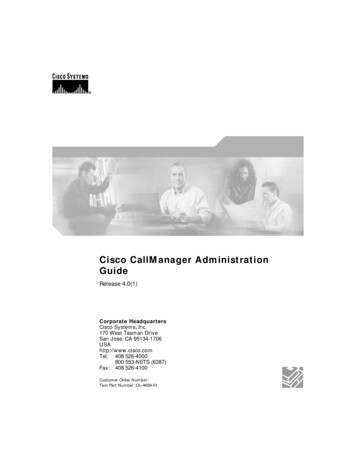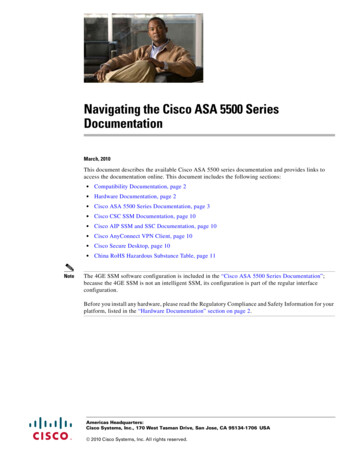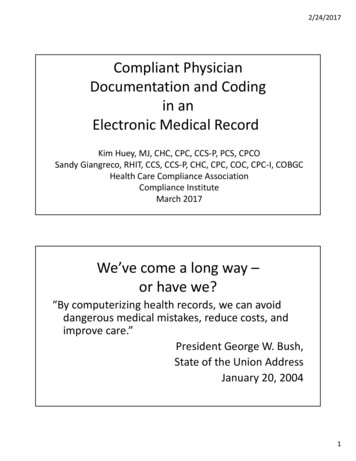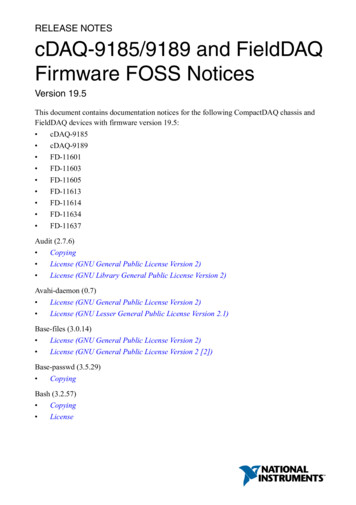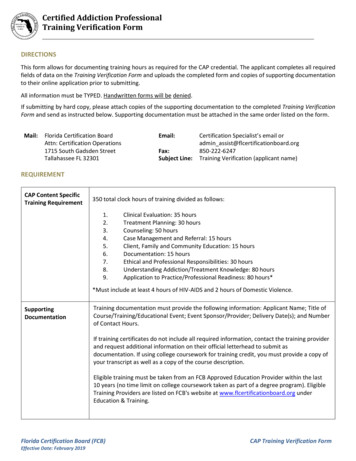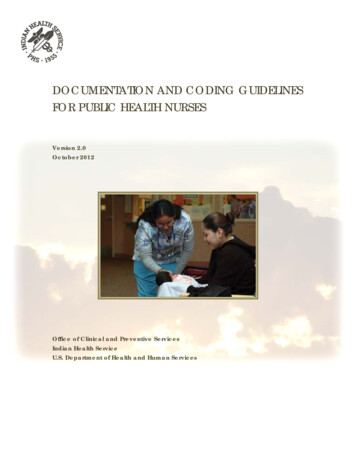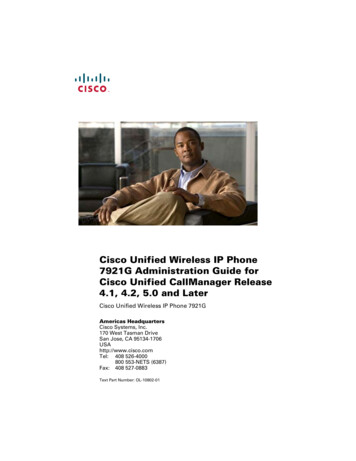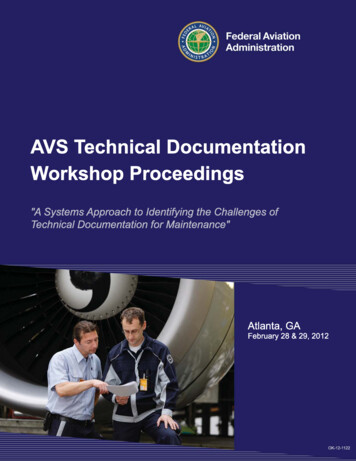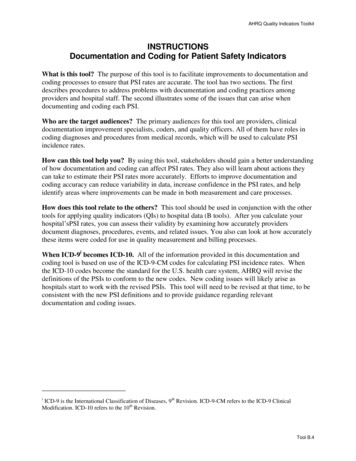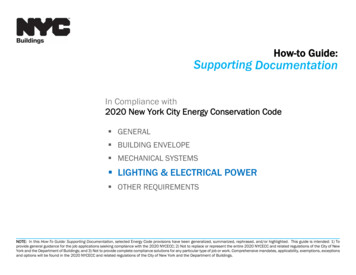
Transcription
How-to Guide:Supporting DocumentationIn Compliance with2020 New York City Energy Conservation Code GENERAL BUILDING ENVELOPE MECHANICAL SYSTEMS LIGHTING & ELECTRICAL POWER OTHER REQUIREMENTSNOTE: In this How-To Guide: Supporting Documentation, selected Energy Code provisions have been generalized, summarized, rephrased, and/or highlighted. This guide is intended: 1) Toprovide general guidance for the job applications seeking compliance with the 2020 NYCECC; 2) Not to replace or represent the entire 2020 NYCECC and related regulations of the City of NewYork and the Department of Buildings; and 3) Not to provide complete compliance solutions for any particular type of job or work. Comprehensive mandates, applicability, exemptions, exceptionsand options will be found in the 2020 NYCECC and related regulations of the City of New York and the Department of Buildings.
INTERIOR LIGHTING POWER Maximum Allowed Interior Lighting PowerC405.39.2.2.3- Light fixture layout plans and light fixture schedules must demonstrate that the proposed interior lighting power density (watts/sf) isnot greater than the maximum allowed interior lighting power density.- Light fixture schedules must be complete with the fixture identification key, lamp/fixture type, number of lamps per fixture, fixturewattage, lamp/ fixture efficacy (in lumens/watt), and quantities that match the light fixture layout plans.1 RCNY §500001(g)(3)- Light fixture schedules must support the lighting energy analysis report: e.g., Lamps/Fixture, # of Fixtures, and Fixture Wattagelisted in Lighting COMcheck report on EN- drawings and must match those values in light fixture schedules on RCP drawings. Referto the page [GE-3].R404.1C405.19.1.1- Fixture efficacy values (lumens/watt), and/or fixtures’ low-voltage information, when pertaining to exemption of certain lightingpower/controls requirements, must also be listed in the light fixture schedules. Allowance Calculation MethodC405.3.29.2.2- The maximum allowed interior Lighting Power Density (LPD) must be determined by either the Building Area Method, or the Spaceby-Space Method. These may not be used in combination.- The selection of one method between the two, by which the allowed LPD of the job application is determined, must be justified bythe building/space programs and work scope of the job application. Building Area MethodC405.3.2.19.2.2.1Interior Lighting Power Allowance The floor area of each Building area type x the LPD value for the Building area type from TableC405.3.2(1), or Table 9.5.1- For the purposes of this method, an ‘area’ is defined as all contiguous spaces that accommodate or are associated with a singlebuilding area type, as listed in Table C405.3.2(1).LIGHTING FIXTURE SCHEDULEFixtureIDLOCATIONA1Apt FoyerA2Apt 678-9012# OF LAMPS/FIXTUREFIXTUREWATTAGE (Watt)LAMP EFFICACY(Lumens/Watt)FIXTURE EFFICACY(Lumens/Watt)TOTAL # 14W T5 (2)LAMP TYPENOTESFigure LE-1. Sample Lighting Fixture Schedule for Residential BuildingGENERALBUILDING ENVELOPEMECHANICAL SYSTEMSLIGHTING & ELECTRICAL POWER [LE - 1]OTHER REQUIREMENTS
INTERIOR LIGHTING POWER Space-by-Space MethodInterior Lighting Power Allowance Sum of (the floor area of each Space type x the LPD value for the Space type from TableC405.3.2(2), or Table 9.6.1)- The space type in the Table that most closely represents the proposed use of each space must be selected so that all spaces inthe work scope are accounted for in the calculation.C405.3.2.29.2.2.2- Trade-offs among spaces are permitted in this method. High-Efficacy Lamps or Luminaires- For Residential buildings, also for Dwelling units within Commercial buildings, a minimum of 90% of the permanently installedlighting fixtures must have:a) Lamp efficacy 65 lumens/watt, orb) Luminaire efficacy 45 lumens/wattR404.1C405.19.4.4- To validate the above, light fixture schedules must clearly identify lamp/luminaire efficacy of each light fixture, and alsolamp/luminaire counts of all lighting fixtures. See Figure LE-1 on the page [LE-1].Figure LE-2. High-Efficacy Lamp examplesSource: basc.pnnl.govGENERALBUILDING ENVELOPEMECHANICAL SYSTEMSLIGHTING & ELECTRICAL POWER [LE - 2]OTHER REQUIREMENTS
OCCUPANT SENSOR CONTROLS* Where Required- Occupant sensor controls are required in spaces including: classrooms, conference rooms, copy rooms, lounges/ break rooms,enclosed offices, open plan offices, restrooms, storage rooms, locker rooms, warehouse storage areas, janitor closets,corridors/transition areas, cafeteria/fast food dining areas, egress illumination (stairways, exit access), and other spaces 300 sf.C405.2.1Table 9.6.1- Light fixture layout plans, fixture schedules, and the controls narrative must clearly identify the location of occupant-sensor-controlledlight fixtures and the connected sensor/control devices. Occupant Sensor (OS) Control Function(NOT for Open Plan Offices, Cafeteria and Fast Food Dining Areas 300 sf)- Automatic-Off: Drawings must specify that occupant sensor controlled luminaires are automatically turned off within 15 minutes of alloccupants leaving the space.- Manual-On or Maximum 50% Automatic-On: Lights turned off by occupant sensor controls must be either manually on, or controlled to beautomatically on maximum 50% of the lighting power in the space.C405.2.1.19.4.1.1.b9.4.1.1.c- Manual-On ONLY: Lights turned off by occupant sensor controls must be only manually on – i.e., max. 50% automatic-on is not allowed –in the following spaces: classrooms, conference/meeting rooms, employee break rooms, and offices 200 sf. The sensors and controlsin these spaces must not have an override switch that converts from manual-on to automatic-on functionality.- Full Automatic-On: Only in the following spaces, occupant sensors with full automatic-on are allowed: open plan offices, public corridors,stairways, restrooms, primary building entrance areas and lobbies, and areas where manual-on operation would endanger the safety orsecurity of the building occupants.- Manual Control to Turn Off: Occupant-sensor-controlled luminaires must also be equipped with manual controls that allow occupants toturn lights off. OS Controls in Open Plan Offices, Cafeteria and Fast Food Dining Areas 300 sf-C405.2.1.1C405.2.1.39.4.1.1.hThe maximum control zone area controlled by one (1) occupant sensing device is 600 sf.A minimum of 80% of all lighting must be automatically turned off within 15 minutes of all occupants leaving the space.Daylight responsive control shall not activate general lighting controls when no occupancy is detected in these spaces.See page [LE-4] for required Time-switch and Light-reduction controls. OS Controls for Egress Illumination- Luminaires servicing Exit access and providing Means of Egress illumination must have controls that automatically reduce the lightingpower by 50 % when unoccupied for more than 15 minutes.- OS with Full Automatic-On of the lighting are allowed- Means of Egress illumination of 0.02 watt/sf and the Building-Code-designated Emergency lighting are exempt from this requirement.C405.2.1.49.4.1.1*For complete controls requirements on ASHRAE 90.1 per space type, refer to Section 9.4.1 and Table 9.6.1.GENERALBUILDING ENVELOPEMECHANICAL SYSTEMSLIGHTING & ELECTRICAL POWER [LE - 3]OTHER REQUIREMENTS
TIME-SWITCH & LIGHT-REDUCTION CONTROLS* Where RequiredC405.2.2- Spaces where “Occupant Sensor Control Function” in page [LE-3] are not provided, and- Open Plan Offices, Cafeteria and Fast Food Dining Areas 300 sfBoth Time-switch controls and Light-reduction controls must be provided. The controls’ function and locations must be clearlyspecified on drawings. Time-Switch Controls (Programmed)Time-switch controls must be designed to:1) Have a minimum 7-day clock,2) Allow to program 7-different day types/week,3) Have an automatic holiday ‘shutoff’ feature,4) Have program backup capabilities in case of power interruption, and5) Include a manually-controlled override switch that, when initiated, permits the controlled lighting to remain on for a maximum of 2hours, and that individually controls a maximum area of 5,000 sf.C405.2.2.1 Light-Reduction Controls (Manual)- Spaces with time-switch controls must also be provided with manual light-reduction controls that allow the occupant to reduce theconnected lighting load by minimum 50%.- Light fixture layout plans must clearly indicate the light-reduction control method, the options of which are as follows:1) Control of all lamps/luminaires2) Dual switching of alternate rows of luminaries3) Switching middle lamp luminaires independently4) Switching each lamp/luminaireFigure LE-4.Light-ReductionControls Method bya) Control of all lamps/luminairesb) Dual switching of alternate rows of luminaries*For complete controls requirements on ASHRAE 90.1 per space type, refer to Section 9.4.1 and Table 9.6.1.GENERALBUILDING ENVELOPEMECHANICAL SYSTEMSC405.2.2.2c) Switching middle lamp luminaires independentlySource: energycodes.govLIGHTING & ELECTRICAL POWER [LE - 4]OTHER REQUIREMENTS
TIME-SWITCH & LIGHT-REDUCTION CONTROLS* Where Time-Switch Controls are ExemptIf the spaces listed below are provided with manual lighting-reduction controls, time-switch controls are not required:1) Sleeping units2) Spaces where patient care is directly provided3) Spaces where an automatic shutoff would endanger occupant safety or security4) Lighting intended for continuous operation5) Shop and laboratory classroomsC405.2.2 Where Light-Reduction Controls are ExemptLight reduction controls are not required in daylight zones with daylight responsive controls complying with Section C405.2.3.C405.2.2.2 For areas/rooms where exemptions of certain lighting controls aresought, the lighting plans and narratives must provide clearinformation to satisfy the exemption requirements.Figure LE-5.a. Patient care area Exempt from Time-Switch ControlsSource: energy.gov/eereFigure LE-5.b. Daylight zone with automatic controls Exempt from Light-Reduction ControlsSource: energycodes.gov/training*For complete controls requirements on ASHRAE 90.1 per space type, refer to Section 9.4.1 and Table 9.6.1.GENERALBUILDING ENVELOPEMECHANICAL SYSTEMSLIGHTING & ELECTRICAL POWER [LE - 5]OTHER REQUIREMENTS
DAYLIGHT-RESPONSIVE CONTROLS* Control Function- For spaces having electric lights 100 watts within daylight zones, independent controls for the lights within daylight zones mustbe specified.- For this purpose, light fixture layout plans must clearly delineate the boundary of each daylight zone, and indicate separatecircuiting and switch control for each zone boundary.C405.2.39.4.1.1.e & f9.7.2.3- Daylight-responsive controls must be designed to be capable of a complete shutoff of lights within each daylight zone, and must beinstalled such that authorized professionals can readily access the controls for calibration. Sidelit Zone- The sidelit zone must be identified on drawings in the floor area adjacent to vertical fenestration.- When the fenestration is located in a wall, the sidelit zone extends:(a) Laterally to the nearest full-height wall, or up to 1-times the height from the floor to the top of the fenestration, and(b) Longitudinally from the edge of the fenestration to the nearest full-height wall, or up to 2 ft, whichever is less.C405.2.3.23.2- For the criteria of the sidelit zone following ASHRAE, refer to the definition of ‘daylight area’ in ASHRAE Section 3.2.(a) Section view(b) Plan view of daylight zone adjacent to fenestration in a wall For the Sidelit Zones defined by ASHRAE,i.e., Primary Sidelighted Area andSecondary Sidelighted Area, refer toFigure 3.2-3 and Figure 3.2-4.Figure LE-6.Sidelit Zone*For complete controls requirements on ASHRAE 90.1, refer to Section 9.4.1 and Table 9.6.1.GENERALBUILDING ENVELOPEMECHANICAL SYSTEMSLIGHTING & ELECTRICAL POWER [LE - 6]OTHER REQUIREMENTS
DAYLIGHT-RESPONSIVE CONTROLS* Toplit ZoneC405.2.3.33.2- The toplit zone must be identified on drawings in the floor area underneath a roof fenestration assembly.- The toplit zone extends laterally and longitudinally beyond the edge of the roof fenestration assembly:(a) To the nearest obstruction that is taller than 0.7-times the ceiling height, or(b) Up to 0.7-times the ceiling height, whichever is less.- For the criteria of the toplit zone following ASHRAE, refer to the definition of ‘daylight area’ in ASHRAE Section 3.2. For the Daylight Zonesunder Rooftop Monitorsfollowing ECC, refer toFigure C405.2.3.3(2) andFigure C405.2.3.3(3).(a) Section view(b) Plan view of daylight zone under a roof fenestration assemblyFigure LE-7.Toplit Zone For the Toplit Zones defined by ASHRAE, i.e.,Daylight area under Roof monitors andDaylight area under Skylight, refer to Figure3.2-1 and Figure 3.2-2.*For complete controls requirements on ASHRAE 90.1, refer to Section 9.4.1 and Table 9.6.1.GENERALBUILDING ENVELOPEMECHANICAL SYSTEMSLIGHTING & ELECTRICAL POWER [LE - 7]OTHER REQUIREMENTS
EXTERIOR LIGHTING POWER Maximum Allowed Exterior Lighting PowerC405.4.19.4.2- Light fixture layout plans and light fixture schedules must demonstrate:Proposed exterior lighting power density (watts/sf) Maximum allowed exterior lighting power density- Light fixture schedules must be complete with fixture identification keys, fixture/lamp type, number of lamps per fixture, and fixturewattages and quantities that match the light fixture layout plans. Calculation of Maximum AllowanceC405.4.11 RCNY §5000-01(g)(3)(ii)9.4.2- The maximum allowed building exterior lighting power must be computed based on Table C405.4.2(2) or Table 9.4.2-2 for theapplicable Exterior Lighting Zone per 1 RCNY §5000-01(g)(3)(ii).Maximum Allowed ExteriorLighting Power Base Site Allowance(per Lighting Zone) Individual Allowance per Area Type(Tradable/Non-Tradable Surfaces)- Trade-offs are allowed only among exterior lighting applications in the Tradable Surfaces of TableC405.4.2(2), or Table 9.4.2-2.Lighting Zone 1:Lighting Zone 2:Lighting Zone 3:Lighting Zone 4:Park landAll R districts, R districts with C overlays and MX districtsM districts, except MX; C districts, except C5, C6 and C overlays on R districtsC5 and C6 districtsExterior Lighting ZoneFigure LE-8. Exterior Lighting Zone per 1 RCNY §5000-01 (g)(3)(ii)Source: energycodes.gov Exterior Lighting Controls(a) Daylight shutoff: Lights automatically turned off when daylight satisfies the lighting needs(b) Decorative lighting shutoff: Building façade and landscape lighting automatically shut off within 1 hour of business closing anduntil 1 hour or less prior to business opening(c) Lighting setback: For lighting not controlled per the (b) above, controls to automatically reduce the lighting by minimum 50%during 12am - 6am, or from 1-hr after the business closing to 1-hr before opening, or when no activity detected for 15 minutes(d) Exterior time-switch control function: Controls with 7-different-day-type-programmable clock and automatic holiday setbackC405.2.6See 9.4.1.2,& 9.4.1.4 forASHRAE(e) Outdoor parking area lighting control: Luminaires of wattage 78 W and mounted at 24’ or less above the ground controlled toautomatically reduce the power by minimum 50% when no activity detected for 15 minutesGENERALBUILDING ENVELOPEMECHANICAL SYSTEMSLIGHTING & ELECTRICAL POWER [LE - 8]OTHER REQUIREMENTS
OTHER LIGHTING REQUIREMENTS Narrative on Lighting System and ControlsOn drawings where light fixture layout plans and schedules are documented, a narrative must be provided to describe the functionand operation of mandatory lighting and power controls.1 RCNY §5000-01(g)(3) Lighting System Functional TestingC408.39.7.3.1Drawings must specify the requirements that:- The approved agency must certify that the installed lighting control systems including occupant sensor controls, time-switchcontrols, and daylight-responsive controls have been tested and perform as intended.- Documents certifying the installed lighting controls meet documented performance criteria of Section C405 must be provided tothe building owner within 90 days of the receipt of the certificate of occupancy. Hotel GuestroomsC405.2.49.4.1.3For hotel and motel guestrooms (sleeping units or guest suites), drawings must specify a master control device that is capable ofautomatically switching off all installed luminaires and switched receptacles within 20 minutes of all occupants leaving theguestroom. Display and Accent LightingDisplay lights, accent lights, and lighting in display cases must be controlled by a dedicated control that is independent of thecontrols for other lighting within the room or space. Controls’ locations must be clearly noted on the light fixture layout plans.C405.2.49.4.1.3 Parking GarageParking garage lighting must be designed so that:1) Lighting is automatically shut off during periods when the space is scheduled to be unoccupied.2) Luminaire lighting power is automatically reduced by minimum 30% within 15 minutes of no activity detected in each lightingzone of maximum 3,600 sf.3) Luminaires for covered garage entrances and exits are separately controlled so the lighting power is automatically reduced byminimum 50% from sunset to sunrise.4) The power to luminaires within 20 ft of perimeter walls with opening-to-wall ratio 40% and no exterior obstructions within 20 ftis reduced in responsive to daylight by minimum 50%.9.4.1.2 Exit SignsLight fixture schedules must indicate that the wattage of exit signs (internally illuminated type signs) is maximum 5 watts per side.GENERALBUILDING ENVELOPEMECHANICAL SYSTEMSLIGHTING & ELECTRICAL POWER [LE - 9]C405.1.19.4.5OTHER REQUIREMENTS
ELECTRICAL POWER REQUIREMENTS Voltage DropThe total voltage drop across the feeder conductors and branch circuits combined must not exceed 5%, unless the feederconductors and branch circuits are dedicated to emergency services.C405.98.4.1 Automatic Receptacle Control8.4.2Drawings must specify that:- Minimum 50% of receptacles in spaces including private offices, conference rooms, and classrooms, etc., and- Minimum 25% of branch circuit feeders in modular furniture are automatically controlled:a) On a scheduled basis, orb) By occupant sensors, orc) By an automated signal from another control or alarm system. Separate Metering for Dwelling Units and Large Tenant SpacesR404.2C405.58.4.58.4.6Drawings must indicate that:- Each dwelling unit in a Group R-2 building must be provided with a separate electrical meter.- Each covered tenant space in a new building must be provided with a separate meter or sub-meter to measure the electricalconsumption of each space. Refer to Section 28-311.2 of the Administrative Code of the City of New York for definitions.- Locations of electrical meters must be shown on plan drawings. Electrical Energy Monitoring for Whole Building(1) New buildings 25,000 sf, or new Group R buildings with common area 10,000 sf, must have measurement devices capable ofrecording electrical energy use every 60 minutes (every 15 minutes for ASHRAE) and the capability to report that use on an hourly,daily, monthly and annual basis.C405.128.4.3(2) New buildings and tenants of new buildings must have measurement devices capable of monitoring electrical energy use separately for:a) Total electrical energy,b) HVAC systems,c) Interior lighting, d) Exterior lighting, and e) Receptacle circuits. [Note (2) is for ASHRAE only.] Supplied Energy Monitoring for Whole Building- For new buildings 25,000 sf, or new Group R buildings with common area 10,000 sf, measurement devices must be installedto individually monitor energy use of the following types of energy supplied by provider/plant outside the building:a) Natural gasb) Fuel oilc) Propaned) Steame) Chiller waterf) Hot waterGENERALBUILDING ENVELOPEMECHANICAL SYSTEMSLIGHTING & ELECTRICAL POWER [LE - 10]C405.1110.4.5.1OTHER REQUIREMENTS
ELECTRICAL POWER REQUIREMENTS Elevator CabsDrawings must specify that:- Lighting efficacy: For each elevator cab’s interior lighting, total lumens divided by total watts must be 35 lumens/watt.- Ventilation fan power: Ventilation fans in elevator cabs without their own air-conditioning system must not consume power 0.33watts/cfm.- Controls to de-energize: When stopped and unoccupied with doors closed for over 15 minutes, cab interior lighting and ventilationsystems must be automatically controlled to be de-energized.C405.8.110.4.3 Traction Elevator Power Conversion SystemC405.8.1.110.4.3.5New traction elevators with a rise 75’ in new buildings must have a power conversion system with the following:- Induction Motors with a Class IE2 efficiency rating, or approved alternative technologies- Transmissions not reducing the efficiency of the combined motor/transmission below that shown for the Class IE2 motor forelevators with capacities below 4,000 lbs.- Regenerative Drive recovering potential energy released during motion and supplying it to the building electrical system Escalators and Moving Walks- Automatic speed reduction: Drawings must specify that escalators and moving walks have controls to automatically reduce speedwhen not conveying passengers.- Regenerative Drive: An escalator designed either for one-way down operation only or for reversible operation must have a variablefrequency regenerative drive that supplies electrical energy to the building electrical system when the escalator is loaded withpassengers whose combined weight 750 lbs. See Figure below.C405.8.210.4.4 Commercial KitchenCommercial kitchen equipment must comply with the minimum efficiency requirements of the Tables listed in the section (at right).C405.1010.4.6Figure LE-11.Escalator Variable Frequency Regenerative DriveGENERALBUILDING ENVELOPEMECHANICAL SYSTEMSLIGHTING & ELECTRICAL POWER [LE - 11]OTHER REQUIREMENTS
C405.3.2 9.2.2 Building Area Method Interior Lighting Power Allowance The floor area of each Building area type x the LPD value for the Building area type from Table C405.3.2(1), or Table 9.5.1 - For the purposes of this method, an 'area' is defined as all contiguous spaces that accommodate or are associated with a single
